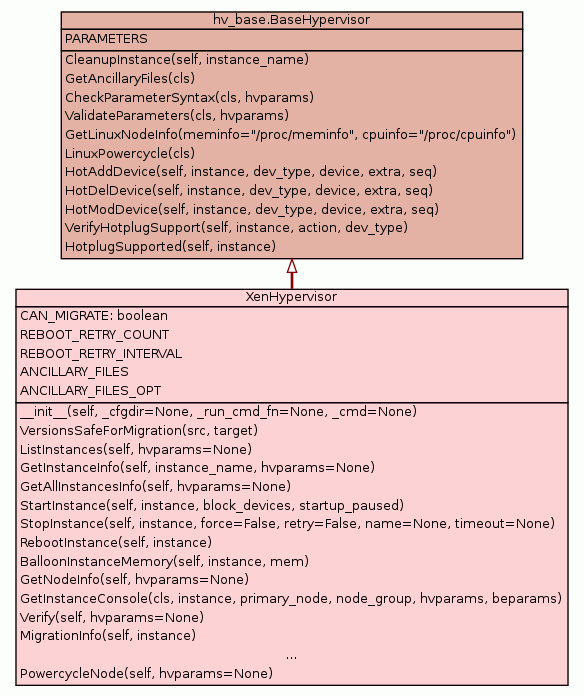
| Trees | Indices | Help |
|
|---|
|
|

Xen generic hypervisor interface
This is the Xen base class used for both Xen PVM and HVM. It contains all the functionality that is identical for both.
|
|||
|
|||
|
|||
|
|||
| str |
|
||
|
|||
|
|||
|
|||
|
|||
|
|||
|
|||
| list of strings |
|
||
| (string, string, int, int, HvInstanceState, int) |
|
||
| (string, string, int, int, HypervisorInstanceState, int) |
|
||
|
|||
|
|||
|
|||
|
|||
|
|||
|
|||
|
|||
|
|||
|
|||
|
|||
|
|||
| string |
|
||
| bool |
|
||
|
|||
|
|||
|
|||
|
|||
|
|||
| objects.MigrationStatus |
|
||
|
|||
|
|||
|
|||
| bool |
|
||
|
Inherited from Inherited from Inherited from |
|||
|
|||
|
|||
|
|||
|
|||
|
|||
|
|||
|
|||
|
|||
|
|||
|
Inherited from Inherited from |
|||
|
|||
|
|||
| bool |
|
||
|
Inherited from Inherited from |
|||
|
|||
| boolean |
CAN_MIGRATE = Truewhether this hypervisor can do migration (either live or non-live) |
||
REBOOT_RETRY_COUNT = 60
|
|||
REBOOT_RETRY_INTERVAL = 10
|
|||
_ROOT_DIR = pathutils.RUN_DIR+ "/xen-hypervisor"
|
|||
_NICS_DIR = _ROOT_DIR+ "/nic"
|
|||
_MIGRATION_DIR = _ROOT_DIR+ "/migration"
|
|||
_DIRS = [_ROOT_DIR, _NICS_DIR, _MIGRATION_DIR]
|
|||
_INSTANCE_LIST_DELAYS = 0.3, 1.5, 1.0
|
|||
_INSTANCE_LIST_TIMEOUT = 5
|
|||
ANCILLARY_FILES = [XEND_CONFIG_FILE, XL_CONFIG_FILE, VIF_BRIDG
|
|||
ANCILLARY_FILES_OPT = [XEND_CONFIG_FILE, XL_CONFIG_FILE,]
|
|||
|
Inherited from |
|||
|
|||
|
Inherited from |
|||
|
|||
x.__init__(...) initializes x; see help(type(x)) for signature
|
Returns the Xen command extracted from the given hvparams.
|
Returns Xen command to use.
|
Wrapper around utils.process.RunCmd to run Xen command.
See Also: utils.process.RunCmd |
Get the config file name for an instance.
|
Makes sure that the directories needed by the hypervisor exist.
|
Write the Xen config file for the instance. This version of the function just writes the config file from static data. |
Decide if migration is likely to suceed for hypervisor versions. Given two versions of a hypervisor, give a guess whether live migration from the one version to the other version is likely to succeed. For Xen, the heuristics is, that an increase by one on the second digit is OK. This fits with the current numbering scheme.
|
Write the Xen config file for the instance. This version of the function just writes the config file from static data. |
Wrapper around module level _GetAllInstanceList.
|
Get the list of running instances.
|
Get instance properties.
|
Get properties of all instances.
|
Gather configuration details and write to disk. See _GetConfig for arguments. |
Start an instance.
|
Stop an instance. A soft shutdown can be interrupted. A hard shutdown tries forever.
|
Shutdown an instance if the instance is running. The '-w' flag waits for shutdown to complete which avoids the need to poll in the case where we want to destroy the domain immediately after shutdown.
|
Destroy an instance if the instance if the instance exists.
|
Stop an instance.
|
Reboot an instance.
|
Balloon an instance memory to a certain value.
|
Return information about the node.
See Also: _GetNodeInfo and _ParseNodeInfo |
Return a command for connecting to the console of an instance.
|
Verify the hypervisor. For Xen, this verifies that the xend process is running.
|
Get instance information to perform a migration.
|
Prepare to accept an instance.
|
Finalize an instance migration. After a successful migration we write the xen config file. We do nothing on a failure, as we did not change anything at accept time.
|
Migrate an instance to a target node. The migration will not be attempted if the instance is not currently running.
|
Migrate an instance to a target node. See Also: MigrateInstance for details |
Finalize the instance migration on the source node.
|
Get the migration status As MigrateInstance for Xen is still blocking, if this method is called it means that MigrateInstance has completed successfully. So we can safely assume that the migration was successful and notify this fact to the client.
|
Xen-specific powercycle. This first does a Linux reboot (which triggers automatically a Xen reboot), and if that fails it tries to do a Xen reboot. The reason we don't try a Xen reboot first is that the xen reboot launches an external command which connects to the Xen hypervisor, and that won't work in case the root filesystem is broken and/or the xend daemon is not working.
|
Check whether the given toolstack is available on the node.
|
Checks whether xl is enabled on an xl-capable node.
|
|
|||
ANCILLARY_FILES
|
| Trees | Indices | Help |
|
|---|
| Generated by Epydoc 3.0.1 on Mon Aug 22 11:13:21 2016 | http://epydoc.sourceforge.net |